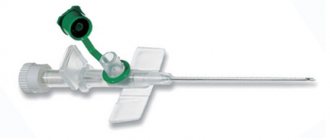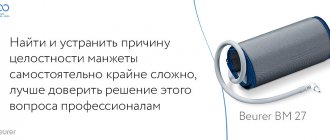Hello everyone! I continue to summarize and post in a condensed form my experience in electronics repair. I present my Top 10 most common malfunctions of tonometers, which was born as a result of accidental repairs of medical equipment and communication with other Masters. I won’t say that I’m a great specialist in this area, but I came across some things and successfully fixed them. Let's start the rating. The locations of malfunctions of tonometers and blood pressure meters are sorted by the frequency of occurrence of the malfunction.
DIY tonometer repair: step-by-step master class
Now digital automatic and semi-automatic blood pressure monitors have become very popular. They are much easier to use than mechanical ones and have fairly accurate indicators.
As for automatic tonometers, they are the easiest to use. For them to work, just put the cuff on your arm and press the corresponding button. The device itself will do the rest.
The semi-automatic device works on the same principle, the only way it differs from the first one is that the air is not pumped by a compressor, but by a rubber bulb manually.
Although automatic appliances seem more attractive, they have their drawbacks. One of them is the mandatory use of high-quality batteries with a large capacity. These batteries are more expensive than regular batteries, but their use is necessary since the air compressor requires sufficient power to operate.
To operate a semi-automatic device, it is enough to have mid-segment batteries, which last for 2-3 years of use. Another advantage of these devices is that replacing the rubber bulb does not require much money or effort. Repairing a compressor can cost a pretty penny, which does not always justify the cost. Sometimes, in such cases, it is better to buy a new device.
A semi-automatic blood pressure monitor can serve faithfully for several years, but over time, it can also develop various problems.
This is due to the wear and tear of some elements, especially those that are most often used. It is clear that there is no point in repairing a rubber bulb or hose. This also applies to the measuring cuff.
Due to their low cost and distribution, they can be purchased at one of the medical equipment stores.
As for electronics, there are ways to independently repair failed elements and circuit components.
In the photo there is 1 microlife tonometer, which has a problem with turning on. To be more precise, to start it, you need to press the “ON” button several times while making circular movements with your finger.
Rice. 1. A tonometer that has a problem turning on
Although the device is more than three years old, it works great. The only drawback is this button, which at the most inopportune moment does not want to perform its function. This can be annoying for someone who is already feeling unwell.
This problem can be easily fixed. It is enough to simply replace the button or solder its contacts. Before drawing a conclusion about a malfunction of the tonometer, its operation should be checked by installing new batteries. Only if after this nothing has changed, then you can think about repairs.
So, you should start by disassembling the case.
Rice. 2. Disassemble the case
To do this, open the battery compartment (Figure 2) and take out all the batteries from there. In this compartment you need to look for the screw securing the two halves of the case. In this tonometer it is hidden under the warranty seal (Figure 3).
Rice. 3. Find the fastening screw
We open the seal and unscrew the screw.
Rice. 4. Unscrew the screw
There is only one in this device, but there are times when there are several of them.
If one of them remains unscrewed, then during disassembly the entire case can be broken. After making sure that all the screws have been removed, we try to separate the two halves of the case using a screwdriver or a knife blade (Figure 5).
Rice. 5. Separate the 2 halves of the body
This should be done carefully, helping with your fingers. After removing the case cover, carefully remove the board and turn it over.
Rice. 6. Remove the board
So that nothing interferes, remove the tube tee from the groove in the housing (Figure 7 and 8).
Rice. 7. Take out the tube teeFig. 8
Now you have access to the soldering points of the problem button pins.
Rice. 9. Tonometer printed circuit board
If you look at the printed circuit board, the two arms of the button are parallel to improve contact. When connected to the terminals of a multimeter button in resistance measurement mode and the button turned on (Figures 10 and 11), the device showed an open circuit, although it should be the other way around. Only when pressing with probes on the solder joints did a chain occasionally appear.
Rice. 10. Check with a multimeterFig. eleven
This indicated a soldering defect, as a result of which the contact did not operate accurately.
Sometimes, over time, a microcrack forms around the output of the part, which may not be visible to the naked eye.
This is especially true for electronic components that are heated or subject to mechanical stress. For example, the same button mentioned above.
If the button turns out to be inoperative, it can be replaced with a similar one from the old technology. For example, from the front panel of a satellite TV tuner or other non-working equipment (Figure 12).
Rice. 12. Example of where to get the button
Also, such buttons are sold on the radio market or online store of electronic components. In this case, the problem was precisely in the folder, and there was no particular need to change the button.
You can solder the pins of the button with a soldering iron with a power of 25 W. A soldering iron with more power can overheat the traces and cause them to peel off. Also, they are not very comfortable to work with because of the thick tip.
To achieve good soldering results, it is necessary to use high-quality flux. The simplest is rosin dissolved in alcohol. You can use regular rosin.
So, we cover the soldering points with flux (Figure 13) and after heating the tool, we solder the connection points of the button pins (Figure 14).
Rice. 13. Cover with flux Fig. 14. Use a soldering iron
There is no need for tin, since what is on the board will be enough.
After soldering is completed, we wipe these places with cotton wool soaked in alcohol or cologne. This will remove debris and excess flux. Next, we connect the multimeter probes to these terminals, and by pressing the button we look at the result.
Rice. 15. Result of soldering
The board should “sit” on the guide plastic pins (Figure 16).
Rice. 16. Reinstall the tonometer board
Next, the tube holder must be installed in the appropriate groove. We cover the board with the top cover and forcefully snap the case into place.
Rice. 17. Install the tube holder into the groove
Tighten the screw in the battery compartment.
Rice. 18. Tighten the screw
We install the batteries and try to turn on the device.
Rice. 19. The tonometer is working! The renovation is complete.
The tonometer turns on the first time, which means that the problem with the button is solved.
Source: https://www.asutpp.ru/remont-tonometra-svoimi-rukami.html
What determines the accuracy of a tonometer?
Cuff fixation
The cuff must be put on in accordance with all the rules provided in the tonometer user manual. If this is not done, then at best the tonometer (automatic or semi-automatic) will produce a measurement error, and at worst – incorrect results, on the basis of which an incorrect idea of the current state of health will be formed. The cuff should be located 1-2 cm above the ulnar fossa and fit snugly to the skin.
Cuff size
The cuff must strictly fit in size, otherwise, if the cuff is small, the pressure measurement result will be overestimated, and if the size is too large, it will be underestimated. The width of the cuff should be 40% of the arm circumference.
Compliance with all rules for measuring blood pressure
The user manual, which is included with the tonometer, shows the rules for measuring blood pressure. It is necessary STRICTLY follow all the listed recommendations, as well as adhere to the basic tips when preparing for blood pressure measurement:
- No smoking for 30 minutes;
- Do not drink coffee, strong tea and alcoholic beverages;
- Rest 15-20 minutes before measuring.
Battery charge
Automatic and semi-automatic blood pressure monitors are powered by batteries, and some models have an adapter for mains operation. If the batteries are low, the tonometer may give an incorrect measurement result.
Breakage of bulb, cuff, pressure gauge, electronic unit
If any malfunctions are noticed, it is recommended to immediately contact the service center. Under no circumstances should you repair the tonometer yourself, especially if it is under warranty.
Tonometer test
To find out which tonometer is more accurate and also most convenient to use, let’s compare devices from popular manufacturers: Omron M1 Eco, Nissei WS-820, AND UA-777, Microlife BP A100, B.Well WA-55, Citizen CH-437C.
As a result of the tests, the tonometer from Omron took the leading position. The functionality of this device is complemented by the ability to calculate the average blood pressure value from the last 3 measurements taken within 10 minutes, which guarantees high accuracy of the result. Also, one of the advantages is the device’s memory - measurement results (with date and time registration) are saved even in the event of a power outage. It is important that if the blood pressure level is elevated, the tonometer gives an alarm in the form of a flashing icon on the display.
The measurement results are most clearly shown by the AND tonometer, using the World Health Organization blood pressure classification, which uses a color scale consisting of three colors indicating the blood pressure level: green - low, yellow - optimal, red - high. The cursor stops next to a specific color corresponding to the blood pressure level. A huge plus is also the fact that this is the only model among the tested tonometers that has control buttons labeled in Russian.
The largest cuff was found in B.Well and Microlife tonometers. The size of the cuff allows the procedure to measure blood pressure in people with a large arm circumference.
How to check the accuracy of the device
Since this question mainly arises during home use, all owners of the device will be able to use the options presented below.
The methods are as follows:
- go to a store that sells medical equipment, where the device will be checked on the equipment provided for this;
- ask for help from a pharmacist who will compare the readings of a new tested tonometer with a previously used one;
- independently if you have a proven tonometer, connecting both devices to the same cuff and comparing the results.
The ideal, but at the same time the most expensive way is to submit the device for testing to a regional standardization center, where the appropriate equipment is available.
Important! Electronic blood pressure monitors are battery operated. If the kit does not include a charging adapter, it means that the manufacturer provides for replacing the battery after a certain cycle of use. Its duration is usually indicated in the instructions.
Checking the accuracy of the tonometer
How to check a blood pressure monitor at home?
Such a check, unlike verification at a government agency, may turn out to be inaccurate, but in most cases it allows you to identify possible malfunctions in the operation of the device.
When purchasing a tonometer, you can check the device directly in the store. To do this, the consultant will check the integrity and tightness of the joints of the tubes, bulb, cuff and make sure that the pressure gauge needle coincides with the o. He will carry out a control measurement with a device tested according to all the rules and measure blood pressure with a purchased device. If they match, then the device you purchase works accurately and can be used.
How to check the accuracy of an electronic blood pressure monitor
? To do this, the consultant checks the integrity of all components and, just as when purchasing a mechanical device, checks the blood pressure readings on the certified tonometer in accordance with all the rules and the purchased tonometer.
The same algorithm for checking a tonometer can be carried out at home, but for this you will need another tonometer, which has been verified by organizations that have been accredited for the right to verify measuring instruments or in standardization, metrology and testing centers (TSM). This is also not always possible and it would be better to contact specialists.
How to check your home blood pressure monitor
, if you do not have the opportunity to check the readings with a device certified by specialists? To do this, you can use the following rules:
- make sure that you are measuring the pressure correctly: whether the cuff is applied correctly, whether all the tubes are intact, whether there are any creases on them, and whether the device is fully charged if the device is electronic;
- if the device is mechanical, then make sure that the pressure gauge needle is strictly on o;
- take several (3-5) measurements with an interval of 5 minutes in a calm state (that is, not after emotional or physical stress, smoking or drinking alcohol and caffeinated drinks);
- calculate the arithmetic average for the upper and lower pressure - it should correspond to your working pressure or age norm.
We have already found out how to check the accuracy of a tonometer at home, now we will look at how to set up a tonometer.
What to do if it measures incorrectly
First, you need to make sure that the blood pressure measurement procedure itself is carried out correctly. Many people use wrist blood pressure monitors, which is not recommended for people over 45 years of age. In addition, the error of such devices can be up to 20 mmHg. Art.
The readings of everyone else can also be influenced by the psychological state at the time of measurement or by incorrect posture.
Having eliminated all factors, all that remains is to take the device to an accredited organization that has a license to service medical devices, where specialists will be able to identify and eliminate the error.










